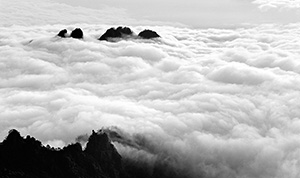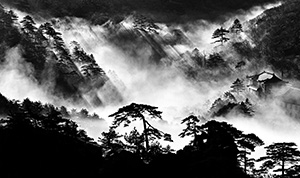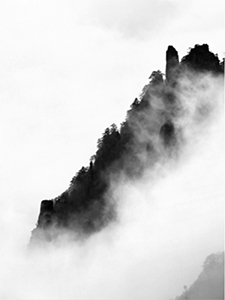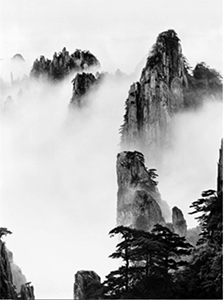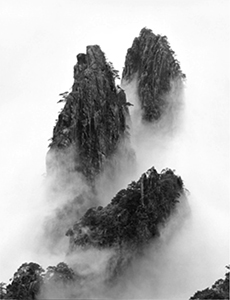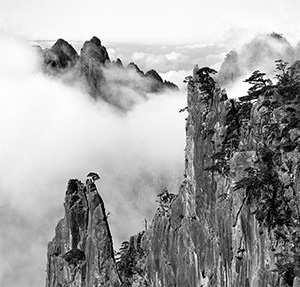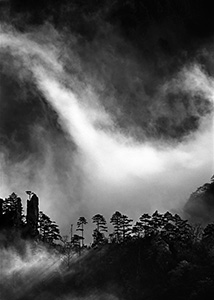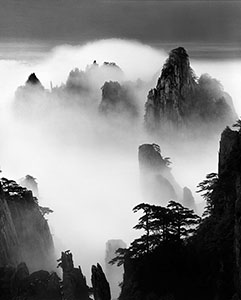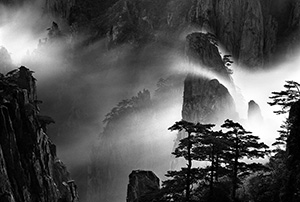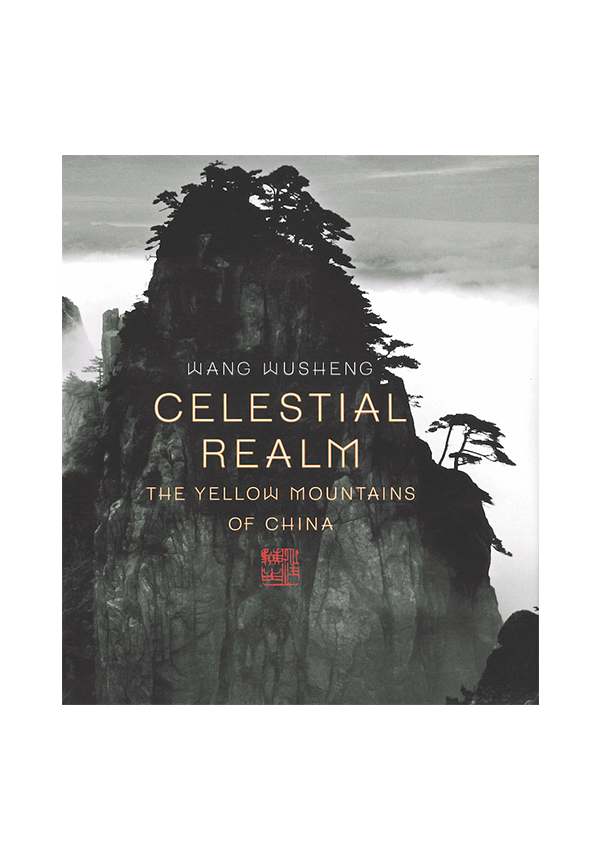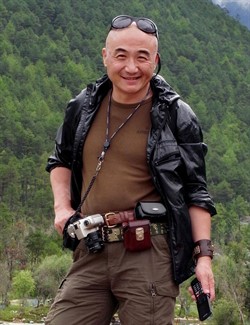IMMORTAL MOUNTAINS IN CHINESE ART
WU HUNG
PHOTOGRAPHING THE YELLOW MOUNTAINS
Shitao died in 1707. Many painters since then have depicted the Yellow Mountains, but none can match his imagination and artistic creativity. The only event that has posed new, conceptual questions to the “art of the Yellow Mountains” was the introduction of photography to China in the second half of the nineteenth century. Before long, amateur and commercial photographers alike had discovered the mountain’s exceedingly photogenic properties. Scenic China (Zhongguo mingsheng), an early serial of landscape photography published by the Commercial Press in Shanghai, devoted its first issue to the Yellow Mountains in 1910. Photographic reproductions of the mountain in this and similar publications impressed the audience with their “painterly” quality. Indeed, many of these images were composed in the manner of traditional ink paintings and took ru hua, “painting- like” or picturesque, as their selling point. When such images were reproduced in advertisements, tourist guidebooks, and even the designs of paper bills, they finally erased the boundary between fine art and popular visual culture. Consequently, a countermovement emerged to restore the elite status of the “art of the Yellow Mountains”—a mission that the noted photographer Lang Jingshan took upon himself in the late 1930s and 1940s.
Born in 1892 in Jiangsu, Lang Jingshan took up the study of photography at age twelve under a teacher of traditional ink painting, who was fascinated with this new visual technology.36 He entered the news business in 1911 when he was nineteen, and became the first professional photojournalist in China when he started to work for Shanghai’s Times newspaper in 1928. In the same year he and some friends founded the Chinese Photography Association to promote art photography and to preserve traditional Chinese culture. This twofold goal motivated him to invent what he called “composite photography” (jijing sheying), and to take the Yellow Mountains as a central subject of his experiments.
According to Lang Jingshan himself, composite photography is akin to photomontage in piecing together fragmentary images into a photographic work, but differs from the latter in its purely artistic aspiration and naturalistic style. In his 1940 essay titled “Composite Picture and Chinese Art,” he described his technique at length, and explained why he considered it the best means to fuse the modern medium of photography with the aesthetics of traditional Chinese painting. In a manner reminiscent of Guo Xi, he theorized a traditional painting as a composit-e image of fragmentary visual memories, and took it as the model of composite photography: Chinese artists of the traditional schools are often accused of painting from imagination. Nothing could be further from the truth. They do not paint from imagination but from memory. What differentiates them from the Western artists is that they paint what they have seen instead of what they are seeing. . . . A collected and retouched view of nature is expressed in the artists’ own work. . . . With composite pictures, photographers can now do just the same as Chinese artists: they now have their choice among natural objects; they may now make their own compositions in photography. Neither time nor space need hereafter be an obstacle. All the products of Nature are now their materials, which can be utilized freely, to construct their “Land of Heart’s Desire.”
Like a traditional Chinese painting, therefore, a composite photograph is a “post-image.” Instead of representing a definitive subject in a fixed moment, it is a fictional construct based on individual images as the photographer’s visual memories. Take his work Majestic Solitude (Chunshu qifeng), for example. It is composed of two snapshots that Lang Jingshan took on different occasions in photographing the Yellow Mountains (fig. 14b). In the final product (fig. 14a), the sharp contrast between the trees in the foreground and the mountain peaks in the background generates a view of great distance, which is further enhanced by the misty mid-ground, a standard feature of a traditional landscape painting. Cautioning viewers not to take such images as mere visual trickery, Lang Jingshan evoked a central concept in traditional Chinese painting theory as his ultimate goal. This concept is qi yuan, “spiritual consonance”:
The most important principle of Chinese painting is “spiritual consonance.” Although we do not have an exact theory of what this means, the essential idea is to imbue a painting with a spirited and animated quality. . . . To be sure, a painting may capture the actual appearance of its subject. But if it does not have an inner life, it only has an external appearance and no soul. This is also true with photography.
Since the time of Lang Jingshan, many Chinese photographers have pictured the Yellow Mountains, and some of them have made this their lifelong obsession. Although they often use qi yuan to describe their pictures, most of them are actually attracted by the picturesque. Their photographs showcase the fractured surfaces of the mountain’s granite cliffs and its strange rock formations, and the seas of clouds that envelop the peaks, leaving the craggy summits looming out of the mist like islands. Embellished with images of twisted pine trees growing from the rocky crevices, these pictures, often in glowing colors, have filled travel magazines and also repeatedly entered national photo exhibitions.
Wang Wusheng’s distinct imagery and his deeper relationship with traditional aesthetics and painting styles separate his work from this general trend. Unlike most of the “Yellow Mountains photographers,” he is not interested in the identity of specific scenes, and only occasionally labeled his pictures with names of peaks or waterfalls. He is not interested in the details of the mountain’s fascinating geology—the deeply fissured rock surfaces, the anthropomorphic contours of peaks, the dangerous, sometimes frightening paths, and the rainbows that occasionally feature miraculous images of the Buddha. His pictures are gorgeous, but their beauty does not come directly from the natural scenery. Rather, the mountain’s natural wonders have been transformed into artistic spectacles through the artist’s commitment to the medium of black-and-white photography, his insistent pursuit of dynamic movement and metamorphic images, and his deep emotional engagement with his subject.
His mountain peaks are often densely dark—a kind of velvet darkness that seems full of color. The Tang dynasty art historian Zhang Yanyuan writes in his Record of the Famous Painters of All the Dynasties (Lidai minghua ji) that in a great painting “ink encompasses all the five colors” (mo fen wu se).39 What he means is that when used well, ink can produce endless layers of subtle shades, implying a multitude of colors without representing them. What the artist can capture in an ink painting, therefore, is not the outward appearance of things, but the yi ?or “mind”—his comprehension of the phenomenal world. Zhang summarizes this view: “If by using ink a painter can allude to the five colors, we say that he has grasped the mind. But if an artist’s mind is fixed on true colors, the essence of things will escape him.”
Wang Wusheng’s pictures manifest the same idea, only his medium is no longer ink painting, but black-and-white photography. His dark mountain peaks are not static, two-dimensional silhouettes, but dynamic substances that interact with other natural phenomena—clouds and mist, wind and rain, light and shadow—in a ceaseless movement. Believing that “the art of the East essentially expresses the artist’s mind (xie yi),”41 he claims that these images reflect his inner vision of the mountain. He writes: “Different cultural background, education, life experience, personalities, and personal interests lead to different responses to the world. Therefore each person forms his or her own unique, subjective ‘Yellow Mountains.’ The Yellow Mountains I have tried to capture over the past thirty years is such a subjective entity in my own mind.”
This does not mean, however, that his images are artificial inventions. To the contrary, he insists that his photographs must be loyal to the real place, and for this reason he rejects Lang Jingshan’s composite picture-making. To him, although a good photograph must express the artist’s vision and personality, it should never violate the nature of photography as a means of spontaneous recording. Any kind of photo editing or computer simulation, in his view, confuses photography with other art forms and undermines its independence. His own method of producing an ideal image requires prolonged experimentation. From selecting a suitable negative to determining the best composition and tonal variation, it often takes several weeks or even several months to make a satisfactory image.43 Interestingly, although he rejects Lang Jingshan’s composite pictures, he shares Lang’s view that as a work of art, a finished photograph is by nature a carefully articulated “post-image.”
Separated from Lang Jingshan by half a century, Wang Wusheng’s photographs represent the impressive achievement of the newest wave of art photography in contemporary China. This wave started in 1979. Before this moment, and especially during the Cultural Revolution (1966–76) mobilized by Mao Zedong to reinvigorate communism in China, publications and exhibitions of photographs in the People’s Republic of China were controlled by the government and served strict propagandist purposes. The appearance of the first unofficial photo club and exhibition in Beijing in 1979 changed this situation fundamentally. Organized by the April Photo Society, the Nature, Society and Man exhibition opened in Beijing’s Sun Yat-sen Park on April 1 that year and created a sensation in China’s capital.44 The exhibition’s preface hailed the idea of art for art’s sake as the exhibition’s goal.
News photos cannot replace the art of photography. Content cannot be equaled with form. Photography as an art should have its own language. It is now time to explore art with the language of art, just as economic matters should be dealt with by using the methods of economics. The beauty of photography lies not necessarily in “important subject matter” or in official ideology, but should be found in nature’s rhythms, in social reality, and in emotions and ideas.
Contemporary Chinese photography has come a long way since that exhibition. A documentary movement emerged in the 1980s and early 1990s, and in turn laid the ground for experimental photographers to undertake wide-ranging artistic experiments since the mid-1990s.46 These later developments, however, do not mean that art photography has disappeared or completely lost its vitality. It is true that the April Photo Society’s advocacy of art for art’s sake has led to formalism and, in the worst cases, to a pretentious, stylized salon style. But as Wang Wusheng’s photographs of the Yellow Mountains demonstrate, art photography remains a vital genre, continuing to produce important works when an artist is passionately committed to it.
Born in 1945 in Anhui, Wang Wusheng was a college student at the beginning of the Cultural Revolution. His field of study, physics, did not prevent him from being considered politically untrustworthy. In 1968 he was sent to an army reclamation farm to receive reeducation. After two years of hard labor, he started to work in a local cultural center and fell in love with photography. In 1974 he made his first trip to the Yellow Mountains. Twenty years later, he recalled his experience at that moment, when he reached the top of the mountain and saw the world with fresh eyes.
I felt that I had left behind the noisy mortal world, and had arrived at the center of the Universe. Nothing here had been contaminated by human society, and everything here was pure, fresh, and harmonious. I was amazed by the vastness and magnificence of heaven and earth. Compared to them, men’s struggle, greediness, and selfishness seemed so pitiful and insignificant. I felt I was confronting history. Compared with the long, eternal movement of history, a man’s life, whether 30 years or 100 years, was no more than a brief instant. My chest had never felt so expansive. I felt I could tolerate anything in the world. My soul seemed purified, and all of my worry and pain had disappeared, like smoke or vapor vanishing of its own accord. My body and mind were filled with peaceful love and benevolence. Since that climb, I have experienced the same powerful feeling whenever I return to the Yellow Mountains. Each time, I stood there five or six hours on end, forgetting everything around me and only savoring this feeling, this beauty. My eyes were moist, and a voice came from the void: “Here is the origin of your art and the meaning of your life.”
Unknowingly, he is repeating what has been said by Zong Bing, the fifth-century monk artist who believed that divine wisdom could be attained through meditating on a sacred mountain. Similar words were also uttered by Qian Qianyi, the seventeenth-century writer and martyr, when he wondered how he could return to the dusty world after visiting this heavenly place. Is this because Wang Wusheng’s experience was close to that of Zong and Qian, who also led uncertain lives in troubled times? Perhaps the real meaning of Wang Wusheng’s emotional outcry on top of the Yellow Mountains can only be comprehended in light of the Cultural Revolution, which displayed “men’s struggles, greediness, and selfishness” at their most intense moment. But his photographs of the mountain seem to rise above the necessity of such contextualization. As many viewers in different countries have told him after seeing his exhibitions, “Your images are timeless.”
